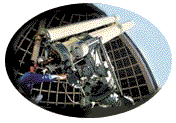|
|

By Dr. Leila Gonzalez
(and friends)
|
We’re looking at the question, "why are the days getting longer?"
Remember! This is a reprint of an article that originally appeared in the LA Times on April 22, 1999. That means the days were getting longer as summer approached.
Exactly how much difference is there between the days?
Some of you are observing the Sun each evening to see if the time it sets changes, others have been getting data from the Web or from the paper. We will talk about your results soon, so send them in (by fax or email). Or, you can log into www.whyville.net and
enter your data at the Sun Spot, where your info will help complete the sun puzzle.
Of course, knowing how much the length of the day changes will not tell us why day length changes. To answer that, we have to consider how
the Sun and Earth move relative to each other. To start thinking about that, I have a way you can safely measure the arc of the Sun across the sky (without looking directly at the Sun).
 | Construct a celestial sphere: For the dome, take an empty 2-liter bottle and, using the bottle’s label as a straight guide, cut off the top. Take a square piece of cardboard and draw a cross through the center and label the points N, E, S, and W. Tape the dome onto the cardboard so that it is centered over the cross. For more accurate data, tape a magnetic compass onto the northeast corner. Be sure that the north-south lines of both the compass and the board are parallel.
|
Now, take your celestial sphere model outside and put
it in a place that stays sunny most of the day. Position it so that the board (or compass) points north. (Ma
rk your location so you can put your model back if it gets moved.)
Take a marker and hold it over the dome. The marker’s tip will cast a shadow, and this shadow must touch the center of the cross on the cardboard. When you have it lined up, mark a dot on the plastic dome and record the time above it.
Make a solar observation every hour or so for as much of the day as possible (weekends are good time to try this).
Try to take 3 measurements before noon, 3 around noon, and 3 more after noon. What
patterns do you find? Which direction is the Sun in the early morning, at noon, and
in the evening?
Be sure to mark the spot where you set up your celestial sphere this week. You will need to put it in the same place next week, as I have more
things for you to try with your model.
 |
Visit the Griffith Observatory in Los
Angeles where you can find out great stuff about the REAL stars (not the Hollywood kind). But, even if you live too far away, you can still
|
Connect to www.griffithobs.org. Their Web site has lots of links to amazing photos and facts. If you are interested in the Sun, planets and other stars,
this is a great site to gaze at.
|
|